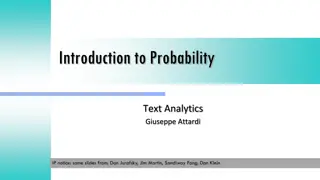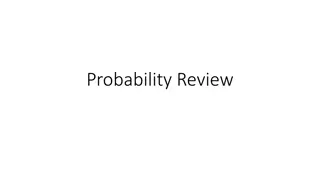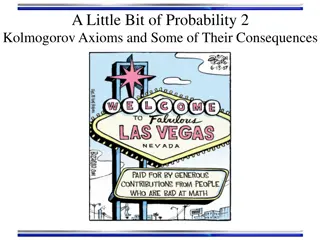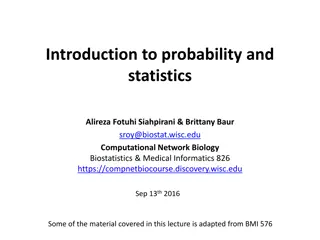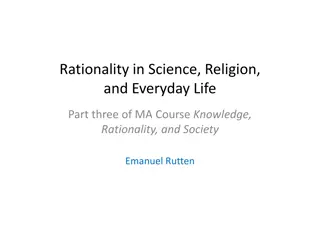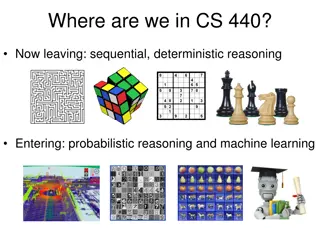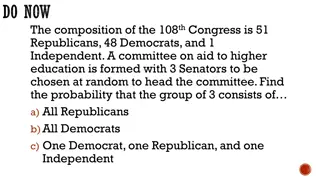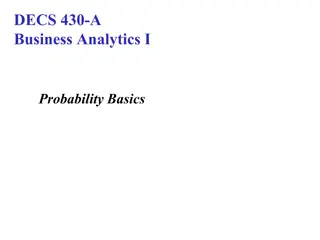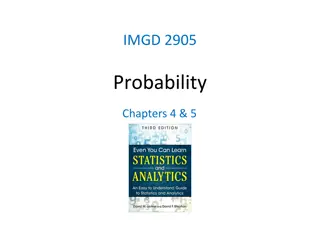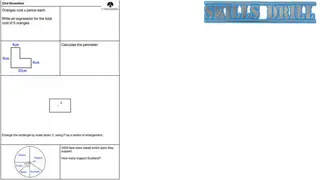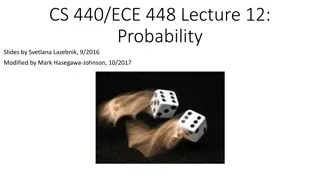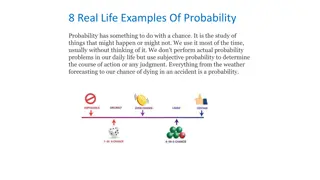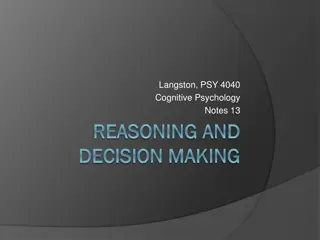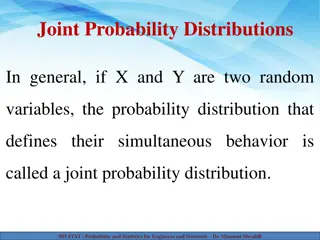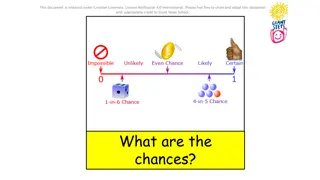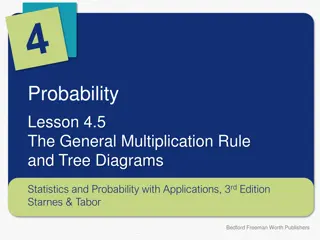Understanding Decision-Making and Probability in Everyday Life
When faced with decisions involving randomness, it's crucial to understand that events of extremely small probability should not be the sole basis for choices. Examples like buying lottery tickets and assessing the risks of terrorist attacks highlight the importance of making informed decisions while considering probabilities realistically.
Download Presentation

Please find below an Image/Link to download the presentation.
The content on the website is provided AS IS for your information and personal use only. It may not be sold, licensed, or shared on other websites without obtaining consent from the author. Download presentation by click this link. If you encounter any issues during the download, it is possible that the publisher has removed the file from their server.
E N D
Presentation Transcript
Data and consumer: danger and opportunity Crystal Wang Foo Jia Yuan Ivan Lieu
Rosenthal, Jeffrey S. (2005). Struck by Lightning: The Curious World of Probabilities, Granta Publications (Chapter 6, Utility Functions: How to Make Decisions)
What is the approach to take when making decisions?
How to Make Decisions The first rule when making decisions about randomness is that events of extremely small probability should generally be ignored. This is a very simple rule that most people do not follow. Here are examples that apply the first rule
Example #1: Buying lottery tickets A typical commercial lottery involves selecting 6 different numbers between 1 to 49. If your 6 numbers match are matched, you win (or share) the big jackpot. The probability of winning the jackpot is one chance in the total number of ways of choosing six different numbers out of 49 choices, which is about one chance in a million. If you bought the tickets once a week, on average you would win the jackpot less than once every 250,000 years. From a practical point of view, this means that when you are deciding whether or not to buy a lottery ticket, the possibility of winning the jackpot should not be a factor in your decision.
Example #1: Buying lottery tickets On occasions, jackpots will grow to enormous size, perhaps even hundreds of million dollars. It is tempting to buy a ticket then, due to the huge payoff. However, the larger the number of people who buy the tickets, the greater the probability of sharing the jackpot. In such circumstances, it is better to choose unusual lottery numbers (best a random choice, worst is 1-2-3-4-5-6) to reduce the risk of sharing.
Example #2: Being killed by terrorist attacks During the period of heightened terrorist attacks from October 2000 through April 2002, there were a total of 319 people killed by terrorist attacks in Israel, about one person in 20,000. By comparison, about 750 Israelis died in motor vehicle accidents during the same time period. Thus, an Israeli was over twice as likely to die in a car crash as to die in a terrorist attack, even during this period of increased terrorist activity. Humans often worry unnecessarily about events of very small probability, which causes us to make poor decisions and to suffer stress and unhappiness.
Example #3: Contracting SARS In 2003, a number of people living in the Toronto area contracted SARS. This outbreak was heavily publicised by the media. But the total number of SARS fatalities was less than 50. By comparison, about 1,000 Canadians die each year from common influenzas. A traveller visiting Toronto, even at the height of the SARS outbreak, was about as likely to die of influenza as of SARS. However, the SARS crisis caused the number of tourists visiting Toronto to decrease dramatically, lead to fall in tourism revenue Overestimating the probability of highly improbable events can have serious consequences.
Randomness and Indifference Ignoring the extremely probable is a sound and rational approach to assist in decision making. However, if taken into the extremes, it could become a reckless and negligent act. How do we then justify this practice?
Example #1: To wear or not to wear a seatbelt? Should we bother wearing a seatbelt if it is a short 10-minute ride and the probability of the getting in an accident is extremely small? Answer is YES! But WHY? Over the course of so many trips, the probability of being in an accident is not inconceivable, hence cannot be ignored It requires little effort, even if the probability is so small, it is worth the effort
Example #2: On a Societal Level Being indifferent based on a decision due to low probability can be detrimental to the society as well. For example, to vote or not to vote during the election? To recycle or not to recycle? To conserve energy or not? One person s efforts may have little impact but if many people do it, then it would start benefitting everyone. The idea is to inspire others to do the same and make a collective effort, then the action taken would be significant
Decision Making Probability theory can work with the probabilities of different outcome However, to make decisions, we also need to consider our preferences and values It depends on our personal rating of desirability or undesirability of different outcomes To quantify our preferences, we can use something called the utility function
Utility Function Science of decision making, often applied to economics, political science and sociology Studied in 1940s by Hungarian mathematician John von Neumann, one of the 6 mathematics professors(along with Albert Einstein) at the world-famous Institute for Advanced Study in Princeton Provides a simple, clear rule for resolving complicated decisions
What is utility function? A personal numerical ratings of the different outcomes that may occur Positive for good things (the higher the better), negative for bad things (the more negative the worse) +10 for watching a good movie, +100,000 for winning the lottery -10 for watching a bad movie, -1,000 for getting fired from your job
Example #1: Wedding plan Decision: Elegant ballroom in city or rustic cabin in forest ? Rustic cabin is incredibly beautiful, but what if it rains? If never rain: Wedding at cabin (+1000), wedding at ballroom (+800) If rain: Wedding at cabin (0), but based on weather forecast, 25% rain chance Cabin worth 1000 with 75% happening, expected utility = 75%X1000 + 25%X0 = +750 Since +800 > +750, choose elegant ballroom
Example #2: Phone call Question: Invite a friend to concert or not? 10% chance that she will accept my invitation If she accepts invitation, it will be fun and exciting (+1000) If she rejects invitation, i will be sad, at most i suffer from the nervousness of calling her and the embarrassment from the rejection (-50) Expected utility from making the call = 10%X(+1000) + 90%X(-50) = +55 Since average utility is positive, make the call !
In conclusion Take situations that are very unlikely to happen with a pinch of salt Apply utility function to guide you to make a decision if you do not know what to do



